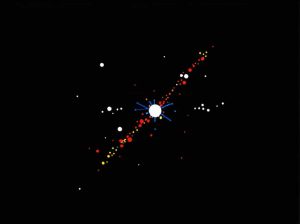Cepheid variable stars are among the most important celestial objects in astronomy. These pulsating stars change in brightness at regular intervals, making them essential tools for measuring distances in the universe. Their unique properties have helped scientists determine the size of our galaxy, discover new galaxies, and even calculate the expansion rate of the universe.
In this topic, we will explore three key facts about Cepheid stars that make them so valuable in astronomy.
1. Cepheid Stars Pulsate Due to the Eddington Valve Mechanism
One of the most fascinating aspects of Cepheid stars is their pulsation cycle—they expand and contract in a regular pattern. This is controlled by a physical process known as the Eddington valve mechanism, or the kappa mechanism, which is driven by changes in helium ionization.
How Does This Process Work?
- When the star’s outer layers contract, helium atoms in the star’s atmosphere become ionized (losing electrons). This increases opacity, preventing energy from escaping.
- Trapped radiation builds up internal pressure, causing the outer layers to expand outward.
- As the star expands, it cools, and helium recombines (gains electrons), reducing opacity. This allows radiation to escape, lowering pressure and causing the layers to contract again.
- This cycle repeats, leading to the regular pulsations observed in Cepheid variables.
This rhythmic expansion and contraction not only changes the star’s size but also affects its brightness, making Cepheid stars appear to “blink” over time.
2. Cepheid Stars Follow the Period-Luminosity Relationship
Cepheid variables have a unique and predictable relationship between their pulsation period and luminosity. This relationship, discovered by astronomer Henrietta Swan Leavitt in 1912, is crucial for measuring cosmic distances.
How Does the Period-Luminosity Relationship Work?
- Longer pulsation periods indicate brighter stars with higher intrinsic luminosity.
- Shorter pulsation periods correspond to dimmer stars with lower luminosity.
- By measuring the time it takes for a Cepheid to complete one pulsation cycle, astronomers can determine its absolute brightness (true luminosity).
- Comparing absolute brightness with its apparent brightness (how bright it appears from Earth) allows scientists to calculate the star’s distance from us.
This discovery transformed astronomy by providing a reliable way to measure vast cosmic distances, leading to groundbreaking findings about galaxies and the expansion of the universe.
3. Cepheid Stars Help Determine the Age and Scale of the Universe
Cepheid variables are not just useful for measuring distances—they have also played a major role in shaping our understanding of the age and expansion rate of the universe.
Hubble’s Use of Cepheids to Discover Other Galaxies
In the 1920s, Edwin Hubble used Cepheid variables to prove that the universe extends far beyond the Milky Way. By measuring Cepheid stars in the Andromeda Galaxy (M31), he determined that it was an entirely separate galaxy, not just a nebula within our own.
Cepheids and the Hubble Constant
Cepheids have also been instrumental in calculating the Hubble Constant, which measures the rate at which the universe is expanding. By studying their distances in different galaxies, astronomers have been able to refine estimates of how fast space itself is stretching.
This has led to significant insights into the Big Bang Theory, helping scientists estimate the age of the universe at approximately 13.8 billion years.
Cepheid variable stars are more than just bright, pulsating objects in the night sky—they are cosmic beacons that have shaped our understanding of the universe. Their pulsation cycles, period-luminosity relationship, and role in measuring cosmic expansion make them some of the most valuable tools in astrophysics.
Through their predictable brightness changes, Cepheids continue to help astronomers unlock the secrets of distant galaxies, refine our understanding of the universe’s scale, and uncover clues about the origins of space and time.



